|

Sidis Archives
Dan Mahony, who compiled all of the research and created this website, passed away in 2016. It was his final wish to keep this site alive and we have promised to do so. A donation in any amount would be appreciated to help cover costs. Thank you.
William James Sidis (SIGH-dis), a world-famous child prodigy said to have been a "prodigious failure," actually wrote many books, articles, and periodicals. He wrote using pseudonyms because he abided by the principles of anonymous contribution and avoidance of fame. Thus through his own choosing the media did not know of his highly productive life. Sidis worked fulltime jobs and did his prodigious thinking and writing on his own time.
The W. J. Sidis Archive presents here all of his writings found so far: four books; four pamphlets; 13 articles; four periodicals (36 issues); 89 weekly magazine columns; a design for a corporation owned and operated by a federation of its employees; and one wonderful invention. Also find here selected correspondence and financial documents. See also Dr. Abraham Sperling's short bio of Sidis; Adam Alonzi's short bio; and Dan Mahony's compilation of materials for biographers Failure?
(Click/tap images to read books, etc. PLEASE CONTINUE SCROLLING TO BOTTOM.)
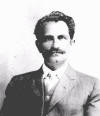 Boris Sidis Archive Boris Sidis Archive
Presents nearly all of the writings of this great psychologist. You'll find here 16 of his 17 books. Find also 45 of his 57 scientific-journal and popular-magazine articles (most of the topics of the other 12 are dealt with in his books); 22 reviews of 13 of his works; and, we assume, all available biographical material. See also The Essential Boris Sidis. Boris is the father of William J. Sidis.
Click/tap images or links to go to source.
W. J. SIDIS MODEL OF THE UNIVERSE
|
 DARK MATTER CONSISTS OF STARS IN THE DARK BUILDUP PHASE OF THEIR ETERNAL CYCLE DARK MATTER CONSISTS OF STARS IN THE DARK BUILDUP PHASE OF THEIR ETERNAL CYCLE
THE UNIVERSE IS INFINITE AND ETERNAL
GALAXIES ARE DISTRIBUTED IN AN IRREGULAR THREE-DIMENSIONAL CHECKERBOARD OF POSITIVE AND NEGATIVE SECTIONS
"We thus find the universe to be made up of a number of what we may call bricks, alternately positive and negative, all of approximately the same volume; a sort of three-dimensional checkerboard, the positive spaces counting as white (giving out light), and the negative spaces as black (absorbing light)."—The Animate and the Inanimate, Chap. XII
shapes of the "brick" sections are made irregular by harmonics
"The irregularity may thus be of two varieties: either the medium pair of faces is caved in, and the largest and smallest bulged out somewhat less; or the largest and smallest pairs of faces are caved in slightly, and the medium pair of faces extremely bulged out."—The Animate and the Inanimate, Chap. XII
A RIGOROUS EXAMINATION OF THE SECOND LAW OF THERMODYNAMICS LED TO THE SIDIS MODEL.
" ... we come to the conclusion that the second law and its reverse are equally probable."—Chapter 4
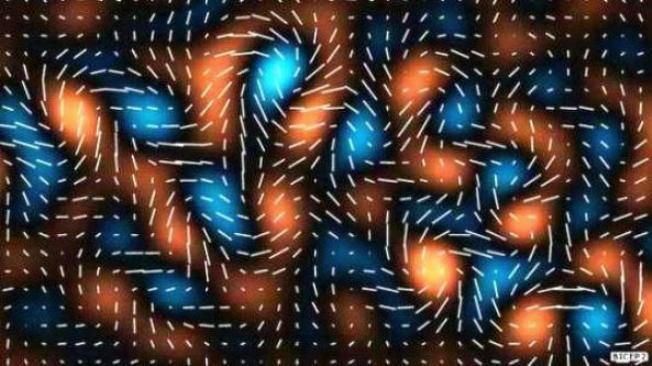 b b
3-D CHECKERBOARD? DARK MATTER (BLUE) SURROUNDING NPRMAL MATTER (RED) AND VICE VERSA. This visualization from BICEP2 is intended to represent the "first tremors of the Big Bang," but instead it illustrates well the Sidis Model. The blue areas represent the negative dark-matter sections, the red the positive ordinary-matter sections, each type surrounding the other as Sidis predicted..
|
SIDIS RE THE STARS
The universe is infinite and eternal.
Stars exist in an eternal darkstar-lightstar cycle.
Galaxies are distributed throughout the universe in an irregular three-dimensional checkerboard of ordinary-matter spaces where they follow the second law of thermodynamics and expend light and heat, and dark-matter spaces where they reverse the second law of thermodynamics and build up heat and do not emit light.
Dark matter consists of hot dark stars still in their galaxies and filaments.
Dark matter makes up 50% of the infinite and eternal universe. " ... we come to the conclusion that the second law and its reverse are equally probable."—Chapter 4
Sidis's theory is a consequence of the laws of physics, e.g., the first law of thermodynamics (energy is neither created nor destroyed).
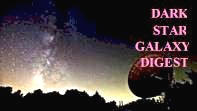
|
|
Derived by re-purposing a Millennium Simulation Project image.
http://wwwmpa.mpa-garching.mpg.de/galform/millennium-II/Images/evol_12panel.jpg
For info on ALMA scroll to bottom of this page.
ANIMATIONS OF SIDIS IRREGULAR THREE-DIMENSIONAL CHECKERBOARD MODEL OF POSITIVE SECTIONS (ORDINARY MATTER) AND NEGATIVE SECTIONS (DARK MATTER), AND ALMA MODEL OF SAME.
SLOWLY, OVER EPOCHS OF TIME, THE NEGATIVE SECTIONS BECOME POSITIVE SECTIONS AGAIN AS THEIR STARS FINISH REVERSING THE SECOND LAW OF THERMODYNAMICS (BUILDING UP HEAT). THEN THEY BEGIN FOLLOWING THE SECOND LAW EXPENDING LIGHT AND HEAT AGAIN.
MEANWHILE, THE POSITIVE SECTIONS HAVING EXPENDED ALL THEIR HEAT GO DARK AND BEGIN REVERSING THE SECOND LAW.
Sidis:
" ... the negative sections must be completely surrounded by positive sections and must therefore be finite in all directions. By reversing this (since we have seen that all physical laws are reversible), it follows that any positive section must also be finite in all directions, and be completely surrounded by negative sections.."—The Animate and the Inanimate, Chap. XII
3-D CHECKERBOARD? DARK MATTER (BLUE) SURROUNDING NORMAL MATTER (GRAY) AND VICE VERSA
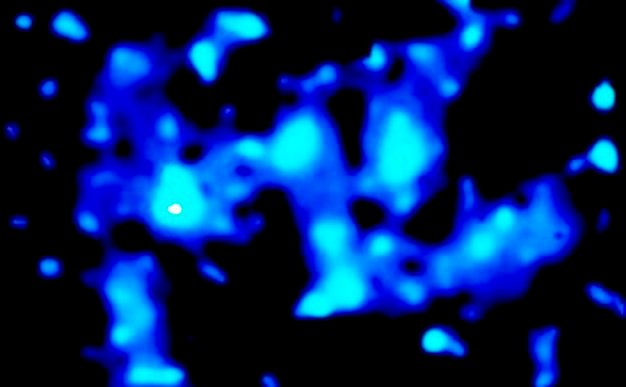
DARK MATTER CONSISTS OF HOT DARK STARS STILL IN THEIR GALAXIES AND FILAMENTS
|
"Our previous consideration on the production of radiant energy from the stars indicates that such production of radiant energy is only possible where the second law of thermodynamics is followed, that is, in a positive section of the universe. In a negative section of the universe the reverse process must take place; namely, space is full of radiant energy, presumably produced in the positive section of space, and the stars use this radiant energy to build up a higher level of heat. All radiant energy in that section of space would tend to be absorbed by the stars, which would thus constitute perfectly black bodies; and very little radiant energy would be produced in that section of space, but would mostly come from beyond the boundary surface. ... If we were on the positive side, as seems to be the case, then we could not see beyond such surface, though we might easily have gravitational or other evidence of bodies existing beyond that surface."—The Animate and the Inanimate, Chap. XII
|
PLEASE READ (FREE):

Recent Cosmology News
LIGHTSTAR DARKSTAR
Let's 'oom into to a dark-matter section
A world that's hot and full of dark stars
Still in their galaxies and filaments
Regaining heat and not shining
They've shone brilliantly in the past
And will yet again
Alternating for eternity their
Lightstar and darkstar epochs
―Will Rike
 " ... we come to the conclusion that the second law and its reverse are equally probable."—Chapter 4 " ... we come to the conclusion that the second law and its reverse are equally probable."—Chapter 4
|
Books by W. J. Sidis
Click/tap images to read / save / print.
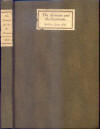 THE ANIMATE AND THE INANIMATE THE ANIMATE AND THE INANIMATE
Sidis starts out noticing something remarkable about the laws of physics: "Among the physical laws it is a general characteristic that there is reversibility in time; that is, should the whole universe trace back the various positions that bodies in it have passed through in a given interval of time, but in the reverse order to that in which these positions actually occurred, then the universe, in this imaginary case, would still obey the same laws." Astronomers are beginning to find the dark galaxies Sidis predicted must exist. Next they will discover the dark stars therein.
 THE TRIBES AND THE STATES 100,000-Year History of North America THE TRIBES AND THE STATES 100,000-Year History of North America
"The weaving of wampum belts was a sort of writing by means of belts of colored beads, in which the various designs of beads denoted different ideas according to a definitely accepted system, which could be read by anyone acquainted with wampum language, irrespective of what the spoken language was. Records and treaties were kept in this manner, and individuals could write letters to one another in this way."
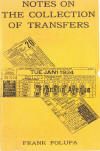 NOTES ON THE COLLECTION OF TRANSFERS NOTES ON THE COLLECTION OF TRANSFERS
"This book is a description of what is, so far as the Author is aware, a new kind of hobby, but one which seems on the face of it to be as reasonable, as interesting, and as instructive, as any other sort of collection fad. This is the collection of street-car transfers and allied forms. The Author himself has already collected over sixteen hundred such forms, there being no duplicates included among that number; and he has found the process of collection, and the things observed during the process, both interesting and entertaining. He believes that others could get the same interest in such collection, even though it were made on a more limited scale." The media industry, believing that this was his only book, proclaimed it evidence that Sidis had "burned out."
 PASSACONAWAY IN THE WHITE MOUNTAINS "The young man who wrote this book commenced his explorations of Passaconaway-land when four years old, at which mature age he climbed to the "turn of the slide" on Mount Passaconaway. With him it was a case of "love at first sight." He cannot remember when he did not love the White Mountains. And with each succeeding year, that feeling has deepened. How the world looks from a Beal-loved little mountain nest―"Score-o'-Peaks"―the youngster will tell. If, by his chapters, he shall succeed in imparting to some weary soul a tithe of the pleasure which has been experienced by one family during nearly a score of summers, I shall think that it was indeed a happy inspiration which led me to suggest to the lad that he record the things herein set down." PASSACONAWAY IN THE WHITE MOUNTAINS "The young man who wrote this book commenced his explorations of Passaconaway-land when four years old, at which mature age he climbed to the "turn of the slide" on Mount Passaconaway. With him it was a case of "love at first sight." He cannot remember when he did not love the White Mountains. And with each succeeding year, that feeling has deepened. How the world looks from a Beal-loved little mountain nest―"Score-o'-Peaks"―the youngster will tell. If, by his chapters, he shall succeed in imparting to some weary soul a tithe of the pleasure which has been experienced by one family during nearly a score of summers, I shall think that it was indeed a happy inspiration which led me to suggest to the lad that he record the things herein set down."
Books Not Yet Found
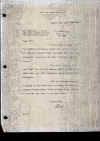 Re Atlantis Manuscript Lawyer's letter indicating publisher interest. Re Atlantis Manuscript Lawyer's letter indicating publisher interest.
"I received a reply from the McClure Newspaper Syndicate. They are evidently interested in your 'Atlantis Manuscript'. They also mention the fact that the selling season starts right after Labor Day, and that therefore quick attention is advisable."
 Re Two More Manuscripts Re Two More Manuscripts
Dr. Sperling's letter to Helena Sidis refers to a manuscript on philology, and another on anthropology, which he showed to a publisher. Sperling wrote: "Mr. McDowell's comments on the manuscripts were these. Both of them he thought were rather scholarly and thus would not lend themselves to publication for popular sale. He suggested that you have some one or more of the outstanding scholars in the the fields of philology and anthropology respectively read both manuscripts for the purpose of passing on their merits and suggesting possible agencies for publication. His feeling was that most commercial publishers would have the same reaction as he had and that you would do best through some educational agency or publication through a scholarly grant."
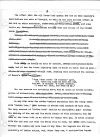 The Peace Path [Fragment] Sidis wrote in a letter: "I am now writing something that I am entitling The Peace Path, on the old courier system and the many ramifications of its consequences in modern life. It seems to be rapidly developing toward book length, and it seems to have interested the few people who have had a chance to read as much of the manuscript as I have gotten ready so far."―1943. The Peace Path [Fragment] Sidis wrote in a letter: "I am now writing something that I am entitling The Peace Path, on the old courier system and the many ramifications of its consequences in modern life. It seems to be rapidly developing toward book length, and it seems to have interested the few people who have had a chance to read as much of the manuscript as I have gotten ready so far."―1943.
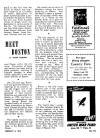 Re guide books to the local transportation systems of Boston and the District of Columbia. "Several volumes, including two for the Boston area and one for the District of Columbia, are now ready to go to the printer, and several more are almost ready." "We know of an unpublished guide book that has complete local transit and street-number information, as well as adequate maps; but it is no good to visitors as long as it remains unpublished." ... "According to an unpublished Boston guide-book .... " Re guide books to the local transportation systems of Boston and the District of Columbia. "Several volumes, including two for the Boston area and one for the District of Columbia, are now ready to go to the printer, and several more are almost ready." "We know of an unpublished guide book that has complete local transit and street-number information, as well as adequate maps; but it is no good to visitors as long as it remains unpublished." ... "According to an unpublished Boston guide-book .... "
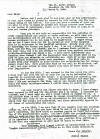 The Libertarian (1943) "I am sending you the latest, and last, issue of The Libertarian." The Libertarian (1943) "I am sending you the latest, and last, issue of The Libertarian."
Invention of Simplified Perpetual Calendar
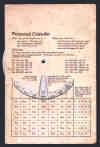 U.S. Patents 1,718,314 and 1,784,117 U.S. Patents 1,718,314 and 1,784,117
"The invention relates to perpetual calendars in which week-days can be found directly for any given date whatever; and its object is, first, to provide a means by which all such week-days can be looked up in a direct, simple and easily understandable manner; secondly, to avoid the cross-reference tables or complex mechanism, one or the other of which have hitherto generally been features of perpetual calendars providing means to look up the week-day of any given date whatever."
Patents Photo Print Your Own
Articles
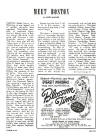 Meet Boston 89 weekly columns presenting interesting facts about Boston and American history: "It is not pure history, nor memory, nor pure fiction, but rather a mixture of all three; not dry research, but affection that puts life-blood into the material."—W. J. Sidis Meet Boston 89 weekly columns presenting interesting facts about Boston and American history: "It is not pure history, nor memory, nor pure fiction, but rather a mixture of all three; not dry research, but affection that puts life-blood into the material."—W. J. Sidis
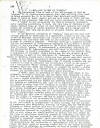 The Concept of "Rights" The Concept of "Rights"
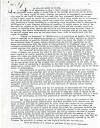 The Extent of Rights The Extent of Rights
 Unconscious Intelligence Unconscious Intelligence
Argument against Freudian theory of the Unconscious.
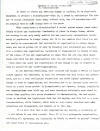 Lessons on Social Continuity ... Sidis's theory of history. Lessons on Social Continuity ... Sidis's theory of history.
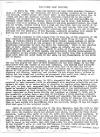 The Modern Gray Champion The Modern Gray Champion
Mysterious figure in American history, first described by Nathaniel Hawthorne. Sidis makes a quite mysterious and uncharacteristic statement: " ... he made his final disappearance, leaving this earth on July 25, 1938."
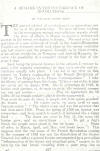 A Remark on the Occurrence of Revolutions A Remark on the Occurrence of Revolutions
Notes correlation of sunspot cycles and political revolutions.
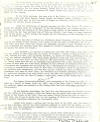 Jersey City Its role in American history. Jersey City Its role in American history.
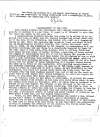 "Railroading" in the Past (ca.1940) "Railroading" in the Past (ca.1940)
His own account of having been "kidnapped by his parents, by arrangement with the district attorney," as a result of guilty verdict for participation in an anti-draft demonstration in 1919.
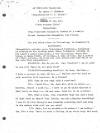 Translation of Chekhov's "An Unwilling Tragedian" Translation of Chekhov's "An Unwilling Tragedian"
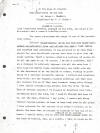 Translation of Chekhov's "On the Harm of Tobacco" Translation of Chekhov's "On the Harm of Tobacco"
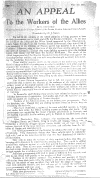 Translation of "An Appeal to the Workers of the Allies" by G. Chicherin (ca. 1919) Translation of "An Appeal to the Workers of the Allies" by G. Chicherin (ca. 1919)
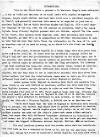 Grammar o th'American Lingo Grammar o th'American Lingo
"This is the first time a grammar o th'American lingo's been attempted in a way as would put American on an equal basis with regular recognized lingoes."
Periodicals
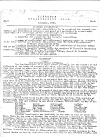 The Peridromophile [No copies found yet.] The Peridromophile [No copies found yet.]
"The Peridromophile is a paper issued primarily for the benefit of the followers of the hobby of transfer and token collection, and who consequently, from that point of view, have an interest in matters relating to local transit all over America. This paper was taken over by Geprodis System on October 16 last, the paper itself having been operated since September, 1926. Its connection with Geprodis System was further strengthened by the fact that the Geprodis Perpetual Calendar, the first unit to be taken over by the Geprodis System, was a development of a "condensed calendar" which appeared in The Peridromophile for January, 1927."--Geprodis Organisation News, Feb., 1930
 Geprodis Organisation News Geprodis Organisation News
"...a new type of organization ... a non-profit membership corporation ... a federation of its employees." (1930)
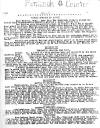 Penacook Courier Penacook Courier
"Courier's own version of American history as though it was a current event."
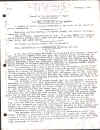 Continuity News "THE PAST IS THE KEY TO THE PRESENT." Continuity News "THE PAST IS THE KEY TO THE PRESENT."
"A libertarian government is essentially a limited government limited by individual rights; the definition not only does not imply majority rule, butdefinitely implies that all rule, whether majority or minority, is strictly limited to the field of preventing transgressions on the rights of any individuals whatever."
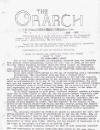 The Orarch The Orarch
"Get used to thinking in terms of Orarchy, not Democracy. 'Orarchy' means limited government―limited in powers and jurisdiction."
 The Libertarian (1943) "I am sending you the latest, and last, issue of The Libertarian." The Libertarian (1943) "I am sending you the latest, and last, issue of The Libertarian."
Pamphlets

"Unfortunately, too many Americans consider the search for liberty as at an end, as if it had been secured and made safe for all time by the founding fathers. To the contrary, the struggle for liberty is one requiring eternal vigilance and today is perhaps more in danger than at any other period in our history." Compilation of little known American history in the form of poetry by John Greenleaf Whittier, Thomas Paine, John Boyle O'Reilly, Oliver Wendell Holmes, Stephen Foster, Lydia Sigourney, and Sidis himself.
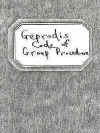 GEPRODIS GEPRODIS
" ... a new type of organization ... a non-profit membership corporation ... a federation of its employees." (1930)
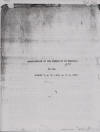 Hesperia Constitution Hesperia Constitution
Design for a utopia written at a young age.
 Conscientious Objector Writings, 1939-1943 Conscientious Objector Writings, 1939-1943
"absolutism, n. the acceptance of or belief in absolute principles in political, philosophical, ethical, or theological matters; absolutist n. & adj. (Oxford Dictionary)."
Letters, Documents, Misc.
 Materials in Sagall Collection Materials in Sagall Collection
 Astronomy Exam Booklet, 1912 Astronomy Exam Booklet, 1912
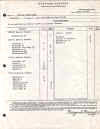 Harvard College Transcript (1916) Harvard College Transcript (1916)
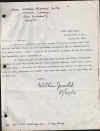 Selected Correspondence Selected Correspondence
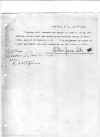 Inheritance Inheritance
 Helena Sidis's Address book contains a number of Sidis's friends. Helena Sidis's Address book contains a number of Sidis's friends.
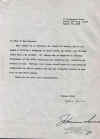 Letter, 08AUG1978, authorizing Dan Mahony to have access to all writings, documents and materials related to W. J. Sidis, Boris Sidis, Sarah M. Sidis, Helena Sidis. Letter, 08AUG1978, authorizing Dan Mahony to have access to all writings, documents and materials related to W. J. Sidis, Boris Sidis, Sarah M. Sidis, Helena Sidis.
Selected Biographical Material
(Tap / Click to open, again to enlarge.)
FORTY-FIVE ITEMS IN THE NEW YORK TIMES 1904 - 1944
re BORIS SIDIS, W. J. SIDIS
(Click / tap images to open, again to enlarge.)
|
[Notice of publication of Multiple Personality]
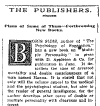
Sat., March 26, 1904
|
TWO MEN IN ONE
Dr. Sidis Considers the Strange Case of T. C. Hannah as an Instance of Multiple Personality
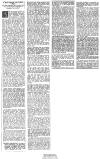
Sat., December 3, 1904
|
[Badger Takes Over Publication of The Journal of Abnormal Psychology]

Sat., Feb.9, 1907 |
IN BOSTON "TECH" AT TEN
Willie Sidis Passes Examinations—Average Age of Freshmen 21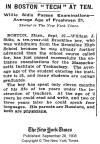
Mon., Sept. 28, 1908 |
A STUDY OF SLEEP

Sat., May 1, 1909
|
HARVARD'S CHILD PRODIGY
All Amazed at Mathematical Grasp of Youngest Matriculate, Aged 13 Years
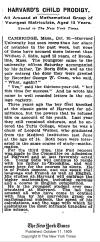
Mon., Oct. 11, 1909
*
A Savant at Thirteen, Young Sidis Knows More on Entering Than Many on Leaving.
A Scholar at Three  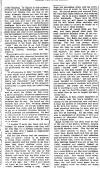
Sun., Oct. 17, 1909
|
SIDIS COULD READ AT TWO YEARS OLD
Youngest Harvard Undergraduate Under Father's Scientific Forcing Process Almost from Birth
GOOD TYPEWRITER AT FOUR
At 5 Composed Textbook on Anatomy, in Grammar School at 6, Then Studied German, French, Latin, and Russian
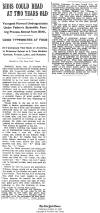
Mon., Oct. 18, 1909 |
SIDIS OF HARVARD

Mon., Oct. 18, 1909 |
BOY OF TEN ADDRESSES HARVARD TEACHERS
Young Sidis Kidnaps the Fourth Dimension and "Revolutionizes Geometry"
PROPOUNDS NEW THEORIES
After the Lecture the Learned Professors Crowd Round the Lad for Further Elucidation

Thursday, Jan. 6, 1910 |
TOPICS OF THE TIMES
Illustrating a System of Education
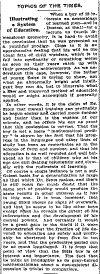
Fri., Jan 7, 1910 |
YOUNG SIDIS'S TRAINING
Demonstration of It Ought to Revolutionize Our Teaching Methods
(To the Editor)
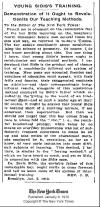
Sun., Jan. 9, 1910 |
HARVARD'S CHILD QUARTET
Sidis, Aged 13, Has Three Rivals 15 Years Old and Younger—One A Girl
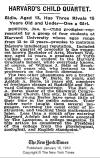
Mon., Jan. 10, 1910 |
The Golden Age of Youth
(To the Editor)
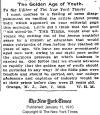
Tue., Jan. 11, 1910
*
SIDIS AN AVATAR?
(To the Editor)
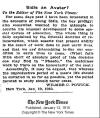
Wed., Jan. 12, 1910
|
HARVARD'S QUARTET OF MENTAL PRODIGIES
Unique Problem for Psychologists in Education of Young Sidis and His Three Contemporaries

Sun., Jan., 16, 1910 |
Wonderful Boys of History Compared with Sidis:
All Except Mcauley Showed Special Ability in Mathematics---Instances of Boys Having "Universal Genius"

Sun., Jan. 16, 1910 |
DR. SIDIS TO CURE HOBBIES
Receives Gift of Estate for Sanitarium
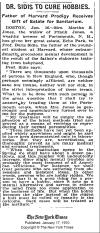
Mon., Jan. 17, 1910 |
REINCARNATION

Mon., Jan.,17, 1910 |
THE FOURTH DIMENSION
It Is a Mathematical Pretension and Quite Profitless
Letter to the Editor
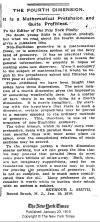
Sun., Jan. 23, 1910 |
SIDIS, BOY PRODIGY, ILL
Attacked With Grip After His Lecture on "The Fourth Dimension"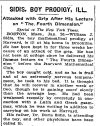
Thurs., Jan. 27, 1910 |
Young Sidis Suffers a Breakdown"
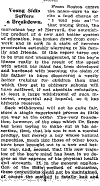
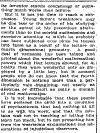
Thurs., Jan. 27, 1910 |
FEAR IS FELT FOR SIDIS
Harvard's Boy Scientist May Never Resume his University Work
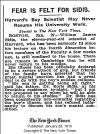
Fri., Jan. 28, 1910 |
FARMER A RIVAL TO HARVARD PRODIGY
Lightning Calculator Demonstrates His Powers to forty University Professors
WORKS INTRICATE PROBLEMS
Multiplication of Figures of Four Digits Each, Cubes of Three Figures, Cube Roots in a Flash

Sat., Feb. 19, 1910 |
TOPICS OF THE WEEK
WILLIAM JAMES SIDIS
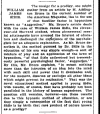
Sat., March 5, 1910
*
PROFESSOR LOWELL AND MASTER SIDIS

Sun., March 27, 1910
|
SEE EUCLID IN SIDIS
Theosophists Believe Harvard Prodigy is the Mathematician Reborn
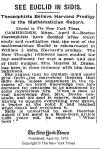
Sun., April 10, 1910 |
"PHILISTINE AND GENIUS"
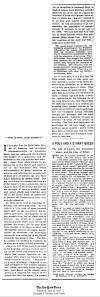
Sun., June 25, 1911
*
DR. SIDIS IN AN UNKIND MOOD
His Vigorous and Bitter Indictment of the American System of Popular Education
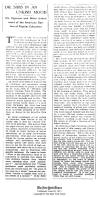
Sun., June 25, 1911
|
THE DORMANT WAKER
Case of Harvard Professor Who Needs No Sleep Explained

Tues., Feb. 18, 1913
|
WHAT IS LAUGHTER?
Dr. Boris Sidis Makes a Serious Study of a Humorous Thing

Sun., July 27, 1913 |
.gif) HARVARD A. B. AT 16 HARVARD A. B. AT 16
William James Sidis the Youngest Student to Get That Degree There
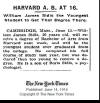
Sun., June 14, 1914, p1. |
HOW TO MAKE GENIUSES OF CHILDREN
H. Addington Bruce Gives the Results of "Intensive Child Culture" as Shown in Such Cases as the Son of Dr. Boris Sidis—New Theories of Education
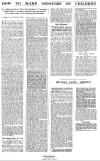
Sun., July 25, 1915 |
A NOVEL MYSTERY
Exciting and Well-Knit Crook Play Based on Abnormal Psychology
JANE GREY SCORES HEAVILY
Cast and Production of Unusual Quality

Wed., Sept. 5, 1917
|
FOUR BOSTON RADICALS GET PRISON SENTENCES

Sat., May 3, 1919
*
Young Sidis, 'Harvard Prodigy,' Sentenced to a Year and a Half in Jail for Rioting

Wed., May 14, 1919
|
When Infant Prodigies Grow Up
Some of Them Who Did Are Confucius, Caesar, Milton, Galileo, Beethoven and Voltaire
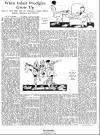
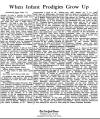
Sun., July 15, 1923
*
DR. BORIS SIDIS DIES
Internationally Known Expert in Psychology Was 56 Years Old
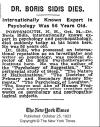
Thu., Oct. 25, 1923
|
TOPICS OF THE TIMES
PRECOCITY DOESN'T WEAR WELL

Fri., Jan 11, 1924
*
YOUTHFUL PRODIGIES AT GENIUS MEETING
Transfer Collector Speaks

Sun., June 20, 1926, p8.
|
SUPREME COURT REJECTS SIDIS SUIT


Tues., Dec. 17, 1940
*
NO PRIVACY FOR PRODIGY
High Court Refuses to Grant Seclusion Thirty Years After
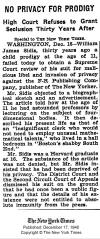
Tues., Dec. 17, 1940
|
SIDIS, A "WONDER" IN BOYHOOD, DIES
Graduate of Harvard at 16.
He Later Sought Jobs Requiring Little Training
RAN ADDING MACHINE HERE
Retiring to Boston He Taught in School Some Called "Bolshevistic"
Tues., July 18, 1944
|
THE HIDDEN GENIUS
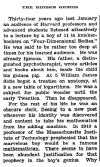
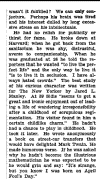
Wed., July 19, 1944 |
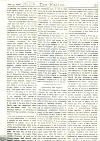 "Precocity and Genius" The Nation (1910) "Precocity and Genius" The Nation (1910)
"The idea that precocity—or at any rate precocity of any such character as this—generally dies down into mediocrity has very little foundation."—(Possibly C. S. Peirce)
 Minutes of the Harvard Math Club, January 5, 1910 Minutes of the Harvard Math Club, January 5, 1910
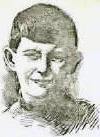 The Boy Prodigy of Harvard (1910) The Boy Prodigy of Harvard (1910)
Has Boris's description of WJ's early education, and excerpts from WJ's talk to the Harvard Math Club
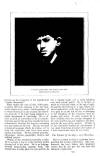 Bending the Twig (1910) Bending the Twig (1910)
Written by a family friend. Quotes Boris Sidis, his father, extensively on WJ's early education, e.g., "My boy plays―plays with his toys, and plays with his books. And that is the key to the whole situation. Get the child so interested in study that study will truly be play." "Dr. Sidis believed that, if properly manipulated, the method of education through play might be extended to subjects not taught in the kindergarten―that, in fact, a child might be led to undertake and continue the study of any subject provided it were made sufficiently interesting to him."
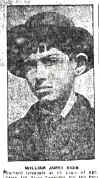 ""Sidis Gets Year and Half in Jail" (1919) ""Sidis Gets Year and Half in Jail" (1919)
This article contains some of his trial testimony re politics, God, etc.
 TOPICS OF THE TIMES: PRECOCITY DOESN'T WEAR WELL TOPICS OF THE TIMES: PRECOCITY DOESN'T WEAR WELL
Fri., Jan 11, 1924
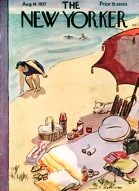 "Where are They Now?" The New Yorker (1937) "Where are They Now?" The New Yorker (1937)
The unkind and untruthful article that led to a US Supreme Court decision cited even today in celebrity cases. Oddly, it is here the wordOkamakammessets appears in print for the first time.
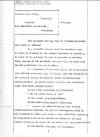 US Appeals Court Decision re Sidis vs. The New Yorker (1941) US Appeals Court Decision re Sidis vs. The New Yorker (1941)
"The intimate details of private life are not entitled to an absolute immunity from the prying of the press, and a limited scrutiny may be had of the private life of any person who has achieved, or has had thrust upon him, the questionable and indefinable status of a 'public figure'."—Chief Justice Brandeis
 "Railroading' in the Past" by W. J. Sidis (ca.1940) "Railroading' in the Past" by W. J. Sidis (ca.1940)
His own account of having been "kidnapped by his parents, by arrangement with the district attorney," as a result of guilty verdict for participation in an anti-draft demonstration in 1919.
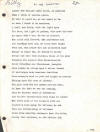 Lament for William James Sidis, An American by Mrs. Sharfman (1944). "I shall see Sidis, with the light upon his face, the light of genius, that made him more an angel than a man. If any man since Leonardo had universal knowledge, it was he." Lament for William James Sidis, An American by Mrs. Sharfman (1944). "I shall see Sidis, with the light upon his face, the light of genius, that made him more an angel than a man. If any man since Leonardo had universal knowledge, it was he."
 Shirley Smith's Letter to the Editor (1944) Shirley Smith's Letter to the Editor (1944)
"Sidis had plenty of loyal friends. All of them found his ideas stimulating and his personality likable."
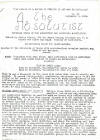 "William James Sidis" by Julius Eichel (1944) "William James Sidis" by Julius Eichel (1944)
"He spoke their language and could read their wampum belts." "Sidis was a libertarian pacifist..."
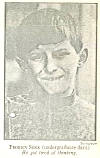 "Prodigious Failure" TIME, July 31, 1944 This magazine actually titled an obituary of a person this way. We provide here documented refutation the many errors in newspapers and magazines.―Dan Mahony "Prodigious Failure" TIME, July 31, 1944 This magazine actually titled an obituary of a person this way. We provide here documented refutation the many errors in newspapers and magazines.―Dan Mahony
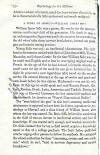 "A Story of Genius—William James Sidis" by Abraham Sperling, Ph.D. "His death in 1944 as an undistinguished figure was made the occasion for reawakening the old wives tales about nervous breakdowns, burned out prodigies and insanity among geniuses." The first to tell the truth about Sidis. Dr. Sperling had seen Sidis's dozen manuscripts. "A Story of Genius—William James Sidis" by Abraham Sperling, Ph.D. "His death in 1944 as an undistinguished figure was made the occasion for reawakening the old wives tales about nervous breakdowns, burned out prodigies and insanity among geniuses." The first to tell the truth about Sidis. Dr. Sperling had seen Sidis's dozen manuscripts..gif)
 The Sidis Story by Sarah Sidis, M.D. (1950) The Sidis Story by Sarah Sidis, M.D. (1950).gif)
"He asked me a question one day, and then triumphantly said, 'But you will say, 'Let's look it up! and I can look it up myself!' That is the last lesson I gave Billy."
More family biographies by Dr. Sarah Sidis (1950's)
 Buckminster Fuller letter re Sidis (1976) Buckminster Fuller letter re Sidis (1976)
"Imagine my excitement and joy on being handed a xerox of Sidis' 1925 book, in which he clearly predicts the black hole."
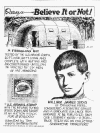 Ripley's Believe It or Not! (1979, 1990) Ripley's Believe It or Not! (1979, 1990)
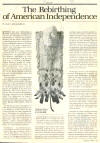 "The Rebirthing of American Independence" by Tracy Ann Robinson (1984) The first magazine article to tell the truth about Sidis. "The Rebirthing of American Independence" by Tracy Ann Robinson (1984) The first magazine article to tell the truth about Sidis.
 "Did the Indians teach the Pilgrims Democracy?" byCathy Spence (1984) The first newspaper article to tell the truth about Sidis. "Did the Indians teach the Pilgrims Democracy?" byCathy Spence (1984) The first newspaper article to tell the truth about Sidis.
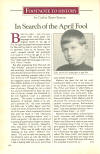 "In Search of the April Fool" by Cathy Spence (1987) "In Search of the April Fool" by Cathy Spence (1987)
The first national magazine article to tell the truth about Sidis.
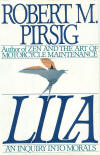 Robert Pirsig re Sidis (1991) Robert Pirsig re Sidis (1991)
"American Indian mysticism is not something alien from American culture. It's a deep submerged hidden root of it."
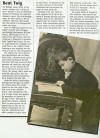 "Bent Twig" in The Mystifying Mind, Time Life Books(1991) "Bent Twig" in The Mystifying Mind, Time Life Books(1991)
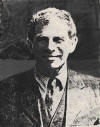 "Failure?" by Dan Mahony (1999) "Failure?" by Dan Mahony (1999) 
"Most research shows that child prodigies go on to lead productive lives―as did Sidis."
Short Annotated Bibliography of Animate and Inanimate Genders in
Basque and Algonquin Languages
"Sidis FAQ" by Dan Mahony (1999)
"Review of The Prodigy" by Martha Brassil (2002)
supermemo.com re W. J. Sidis (2003)
 Peter Vandermark: Portsmouth Photographs (2004) Peter Vandermark: Portsmouth Photographs (2004)
 "Notes on the Collection of Sidis's Pseudonyms" by Dan Mahony (2004) "Notes on the Collection of Sidis's Pseudonyms" by Dan Mahony (2004)
See also:
quantonics.com for additional Sidis material and comment.
"Sidis will be known to all school children of Earth's future, given the efforts of a few on his behalf now."―Doug Renselle
Jay Dillon: Rare Books + Manuscripts
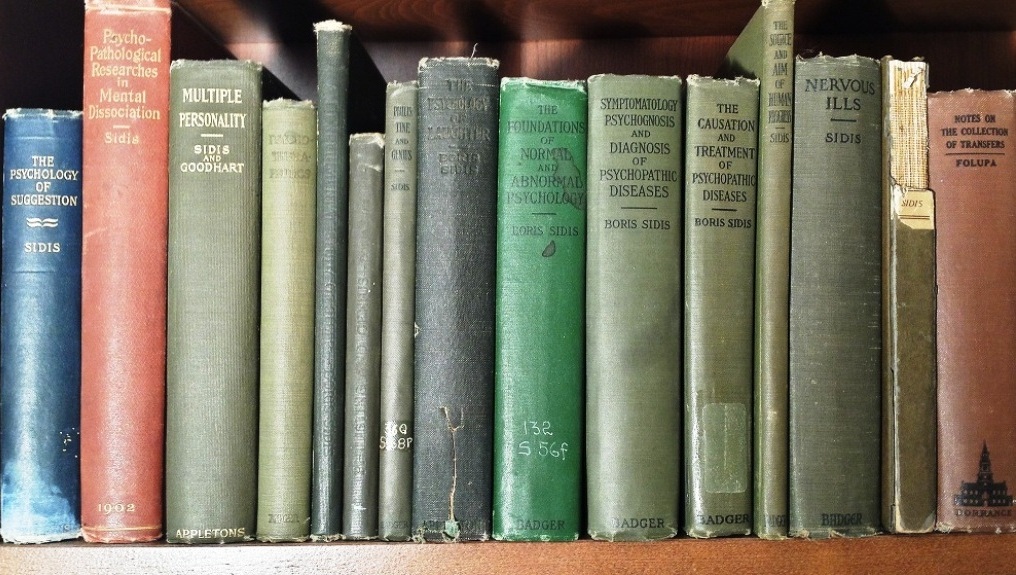
LEON HANSEN'S SIDIS COLLECTION
| The Psychology of Suggestion | Psychopathological Researches | Multiple Personality | Psychotherapeutics | An Experimental Study of Sleep | Philistine and Genius (1911) | Philistine and Genius (1917) | The Psychology of Laughter | The Foundations of Normal and Abnormal Psychology | Symptomatology Psychognosis and Diagnosis of Psychopathic Diseases | The Causation and Treatment of Psychopathic Diseases | The Source and Aim of Human Progress | Nervous Ills
W. J. SIDIS
| The Animate and the Inanimate | Notes on the Collection of Transfers |
.gif) Volunteers needed to translate The Animate and the Inanimate into Spanish and Mandarin. Volunteers needed to translate The Animate and the Inanimate into Spanish and Mandarin.
Your comment, questions, suggestions, or reports of typos are welcome. Email dan at sidis dot net.
Links for Students
Begins with history of the early peoples of the Western Hemisphere, and progresses chronologically, from a new point of view, through the founding of America.
Biography
Biographical Links
Annotated Bibliography
Eichel Collection
Journalistic Links
quantonics.com
Library of Congress Online Catalog
|
Contributors to the Sidis Project (1976-1999) in order of appearance: Dan Mahony (Founder), Dr. Sara Zarem, Ella Maezel, Helena Sidis, Martin Dworkin, Maria Taranto, Elliot Sagall, M.D., Grace Spinelli, Jim Bernstein, Issac 'Rab' Rabinowitz, Anne H. Feinzig, Robin Lagemann, Chicotoneepa (Slow Turtle), Wampanoag Cultural Center, Tom Reilly, Harold "Doc" Humes, Larry Nobile, Robert Bearce, Andrew Bearce, Tom Mahony, Diana Segara, Devin Mahony, Amy Wallace.
Contributors to sidis.net (1999-present) in order of appearance: Dan Mahony, (Founder, Director, Digital Curation; Leon Hansen, Digital Curator.
Doug Renselle, Martha Brassil, Frankie Dintino, Jason Stanfield, Nick Duvoisin, Max Patten, Michael Sechrist, Joshua Freeman, Bob Luhrs, Nicole Copernicus, N. Lygeros, Ph.D., Mike Perry, Bill Paton, Bobbi Jordan, Lane Branscombe, Ryan Messner, Alvie Singer, Terry 25odd6, Valerie Orloff, Patrice Deloche, Robbie Dawson, Georgia Triantafyllidi, Johan Källvide, Leon Hansen, Robert Underwood, Peter Vandermark, Jay Dillon, Stuart Kut, Michael J. P. Cunneen, Adam Gibgot, Dylan Knight Rogers, Michael Round & family, Ann Hulbert, Stephen Bates, David Sachs, Gillian Holmes, Adam Alonzi, Randy Brummett, Jr., "W," ...
In Memoriam:
Helena Sidis, Robin Lagemann, Amy Wallace
|
Graphic at top by Leon Hansen,
Web-design by Dan Mahony.
Thank you for your visit. 
© 1999 - 2016 by Dan Mahony, M.Phil.
|



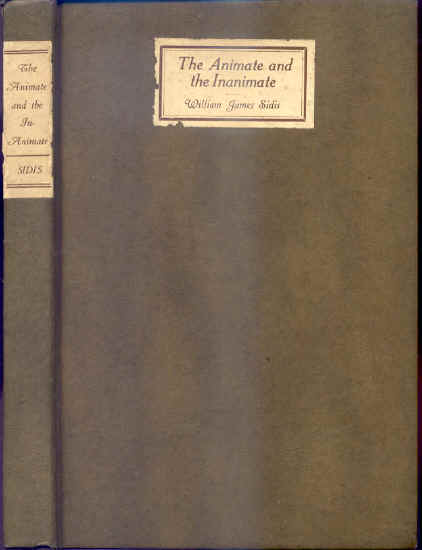













 The
The The Extent of Rights
The Extent of Rights











 Continuity News
Continuity News










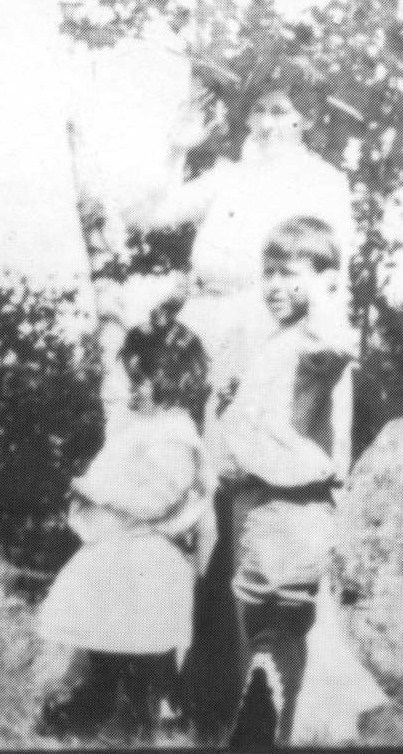
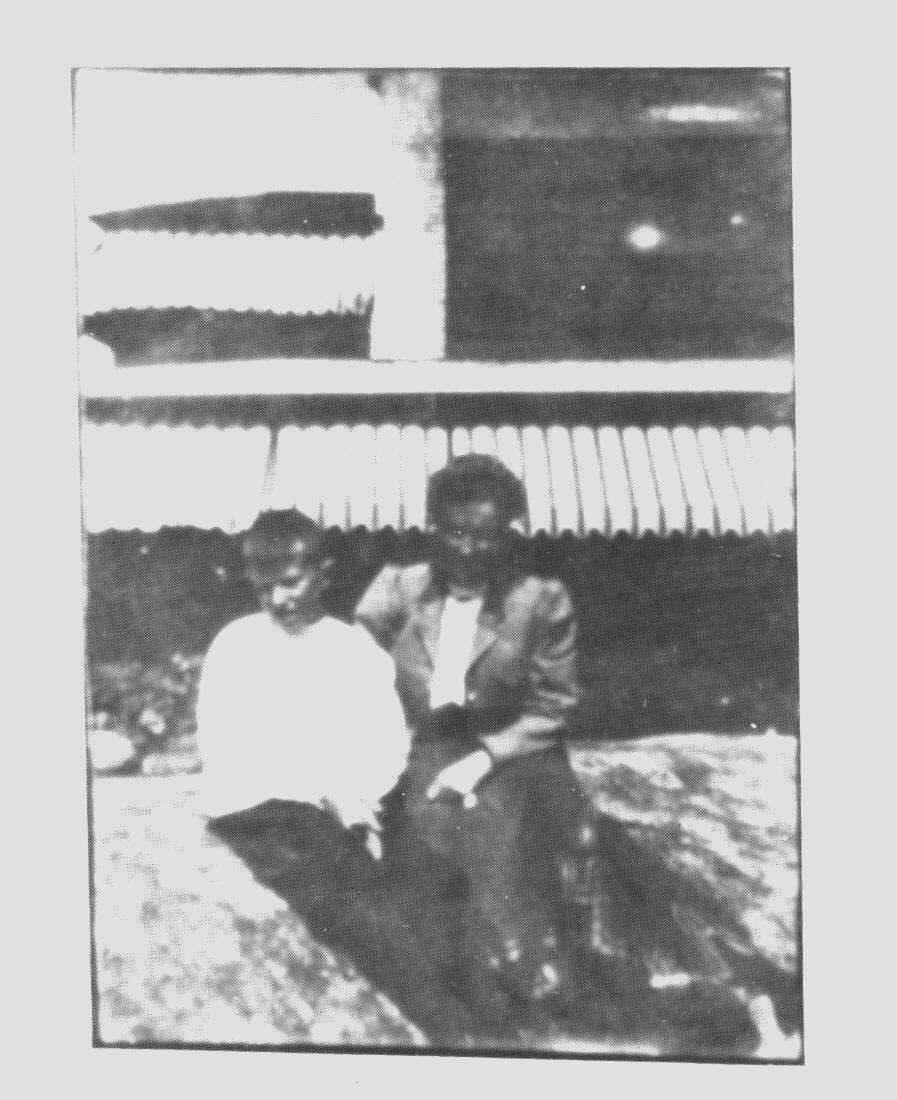
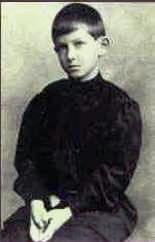
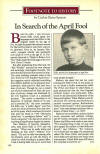
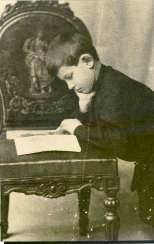
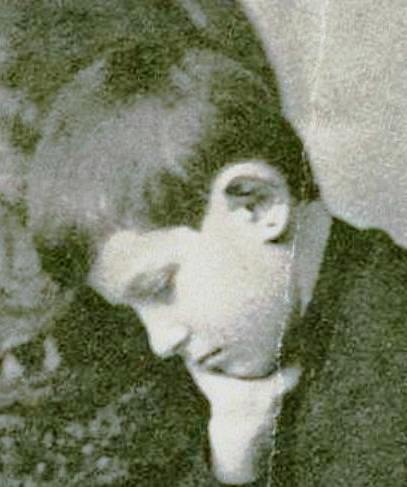
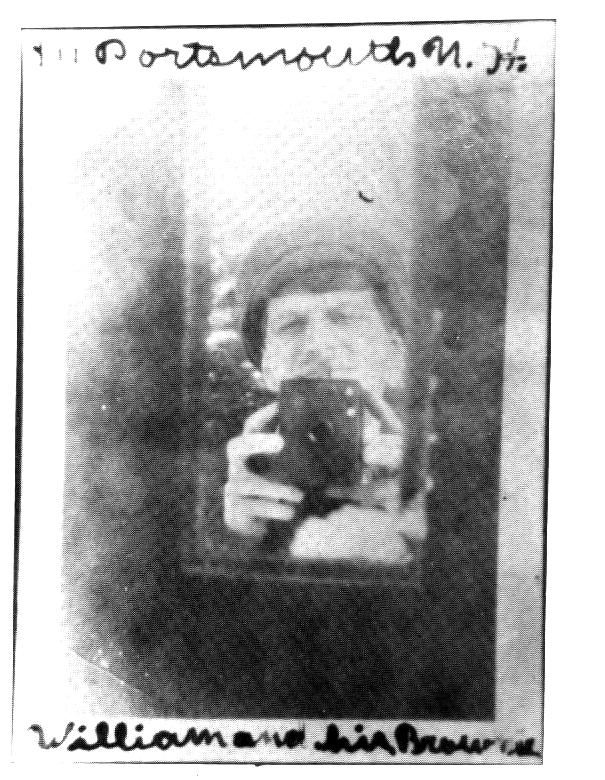
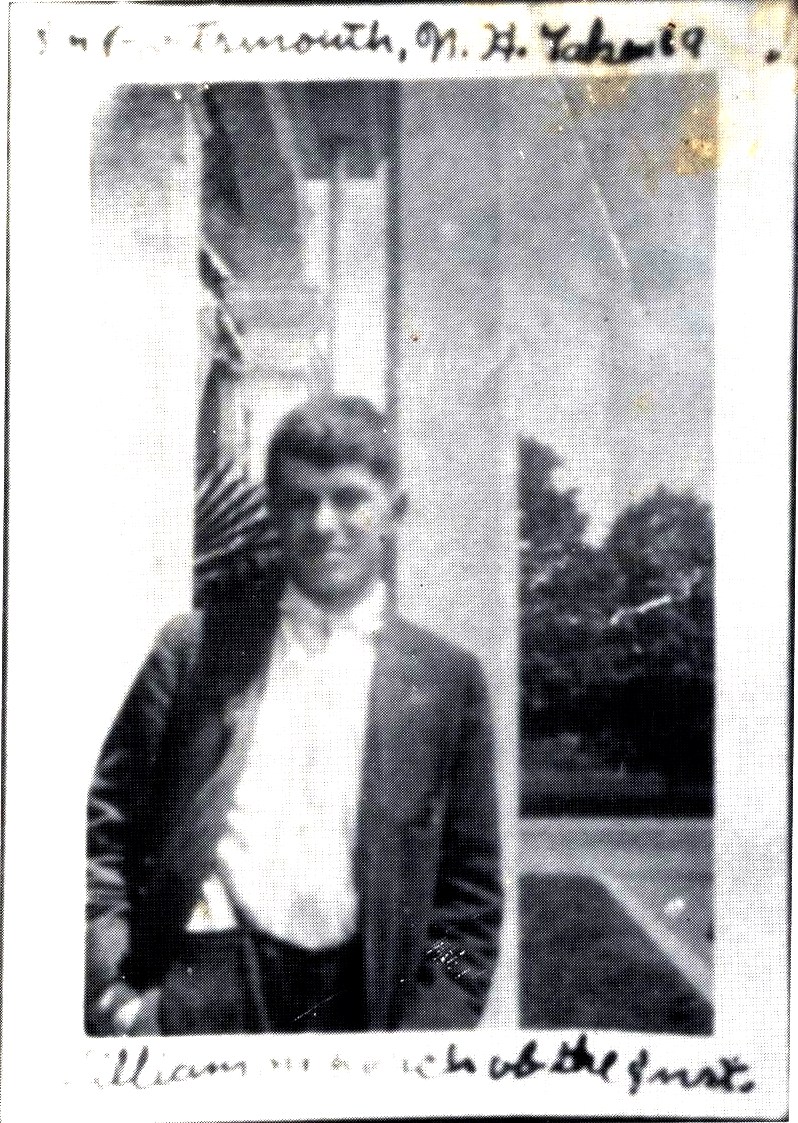
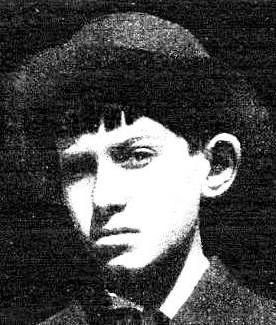
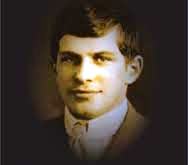
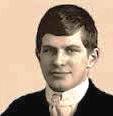
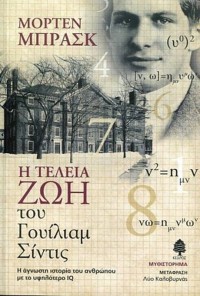
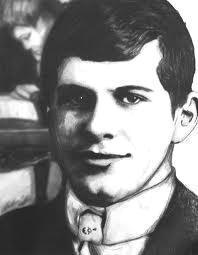
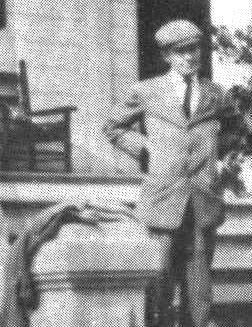
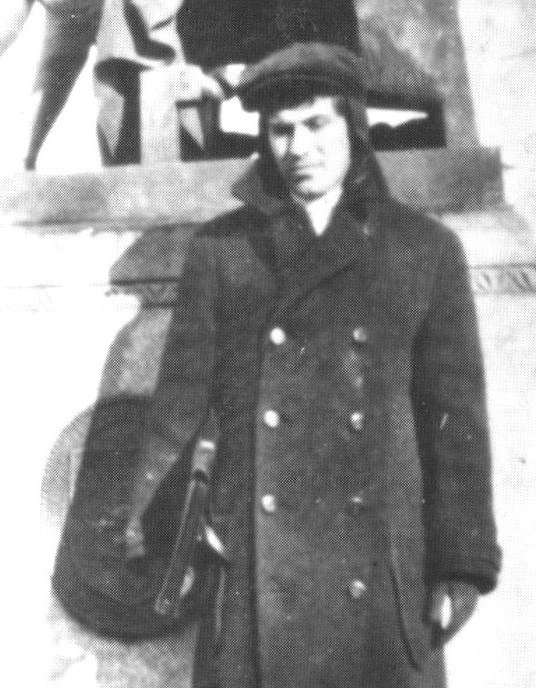
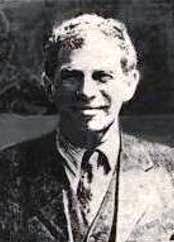
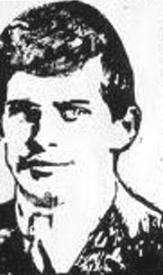
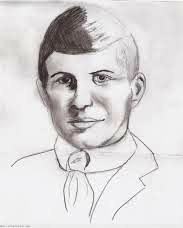
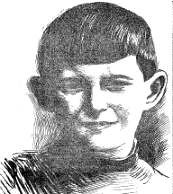
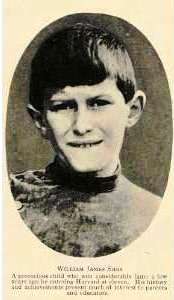
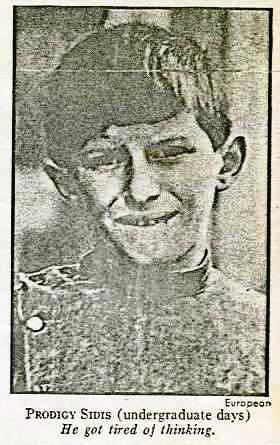
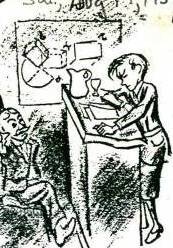
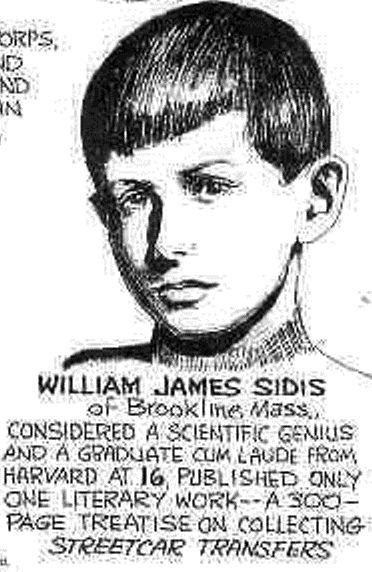
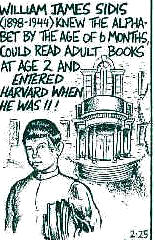



























































 "A Story of Genius—William James Sidis" by Abraham Sperling, Ph.D.
"A Story of Genius—William James Sidis" by Abraham Sperling, Ph.D.









